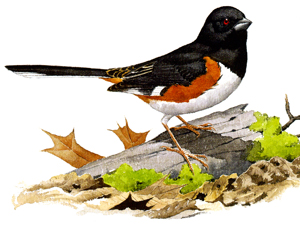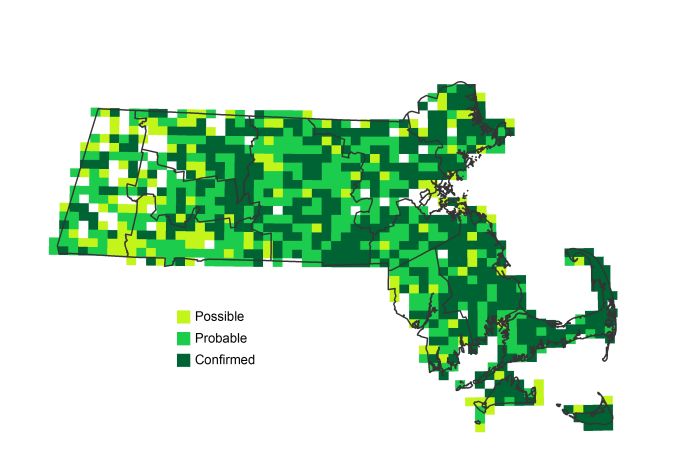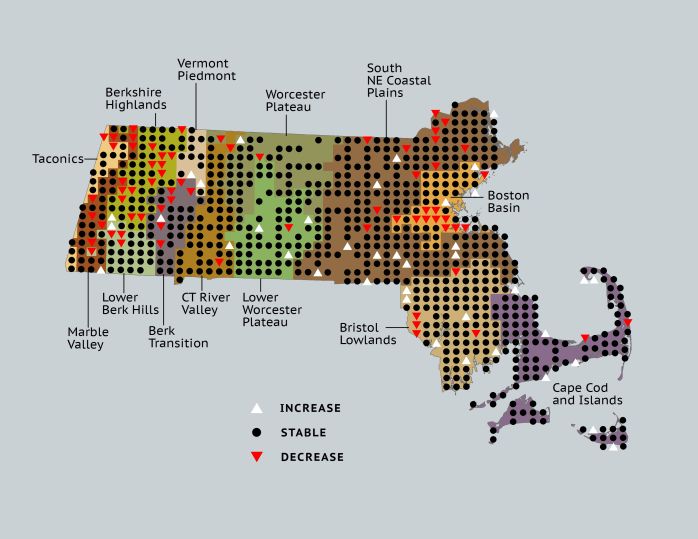Breeding Bird Atlases (BBA)
Find a Bird
Eastern Towhee
Pipilo erythrophthalmus

Nearly ubiquitous and likely declining
Conservation action urgent
State Wildlife Action Plan listed
“the only bird / I can see / the only creature / out there / in the dregs of weather / my sweet / little secret / the drab / nondescript / one / and only / brown towhee.” – Joseph Stroud, “Brown Towhee”
The Eastern Towhee is named for the loud, husky, two-syllable call notes that it utters as it hops through the undergrowth in search of food. This large, handsome sparrow relative is a familiar sight in Massachusetts during the breeding season, but is becoming less so. Loss of young forest and shrubland habitat appears to be placing pressure on Eastern Towhee populations throughout the eastern US. Though still widespread and familiar where suitable conditions exist, Eastern Towhees appear to be losing in their struggle to find suitable breeding sites in a changing landscape.
Historic Status
The Eastern Towhee has been named onomatopoeically numerous times, with names such as Peewink, Chewink, and Towhee. Regardless of its name, since the earliest recorded observations in Massachusetts were made it has been variously listed as abundant or common and “wedded to life in the thicket and tangle,” according to Edward Howe Forbush (Forbush 1929). Despite the fact that Massachusetts has historically been near the northeastern corner of the towhee’s breeding range, there is little evidence our towhee numbers seriously wavered in the period prior to Atlas 1. Although it would seem likely that the period of forest regeneration after the great agrarian age may have been a heyday for the species.
Atlas 1 Distribution
The distribution of Eastern Towhees in Atlas 1 encompassed the entirety of the state, and they were found in 90% of the blocks surveyed. Wooded edges, overgrown thickets, and similar habitats statewide sheltered towhees aplenty. The Vermont Piedmont actually had the lowest block occupancy of any western region at 82% – a testament to the species’ considerable overall presence in Massachusetts. The Lower Worcester Plateau had a similar concentration, but towhees were even more widespread in the Worcester Plateau, again reaching the 92% level. The Coastal Plains also had plenty of towhees in open woodlands and shrubby lots, and only the heart of Boston lacked breeding towhees in the Boston Basin. The Bristol/Narragansett Lowlands were well occupied centers of Eastern Towhee distribution, despite a few gaps.
Atlas 2 Distribution and Change
Surprisingly, Eastern Towhees did not manage to match their Atlas 1 distribution, and were found in 88% of the blocks surveyed in Atlas 2. Perhaps as strong an environmental indicator as with any species in Atlas 2, the Eastern Towhee notably retreated from two sections of the state. The far west, in all their ecoregions, witnessed a major withdrawal of this species, and the settled Boston Basin also showed a decline. Maturing forests – former farmlands that have already passed through the early successional shrubland stage – have now become inhospitable to this species, forcing it to look for homes elsewhere. The only ecoregion that experienced any towhee population upticks was Cape Cod and the Islands, and even there these increases were marginal.
Atlas 1 Map

Atlas 2 Map

Atlas Change Map

Ecoregion Data
Atlas 1 | Atlas 2 | Change | ||||||
Ecoregion | # Blocks | % Blocks | % of Range | # Blocks | % Blocks | % of Range | Change in # Blocks | Change in % Blocks |
Taconic Mountains | 15 | 93.8 | 1.7 | 19 | 76.0 | 2.1 | -2 | -13.3 |
Marble Valleys/Housatonic Valley | 38 | 97.4 | 4.4 | 30 | 76.9 | 3.3 | -8 | -20.5 |
Berkshire Highlands | 52 | 94.5 | 6.0 | 41 | 74.5 | 4.5 | -12 | -22.6 |
Lower Berkshire Hills | 27 | 96.4 | 3.1 | 25 | 80.6 | 2.7 | -3 | -11.1 |
Vermont Piedmont | 14 | 82.4 | 1.6 | 17 | 100.0 | 1.9 | 2 | 16.7 |
Berkshire Transition | 36 | 94.7 | 4.1 | 33 | 82.5 | 3.6 | -6 | -19.4 |
Connecticut River Valley | 51 | 91.1 | 5.9 | 58 | 89.2 | 6.4 | -1 | -2.1 |
Worcester Plateau | 72 | 92.3 | 8.3 | 85 | 96.6 | 9.3 | 0 | 0.0 |
Lower Worcester Plateau | 62 | 83.8 | 7.1 | 77 | 96.3 | 8.4 | 1 | 1.9 |
S. New England Coastal Plains and Hills | 252 | 93.3 | 28.9 | 261 | 92.2 | 28.6 | 0 | 0.0 |
Boston Basin | 45 | 80.4 | 5.2 | 38 | 67.9 | 4.2 | -8 | -14.5 |
Bristol and Narragansett Lowlands | 97 | 91.5 | 11.1 | 101 | 88.6 | 11.1 | 1 | 1.0 |
Cape Cod and Islands | 110 | 80.9 | 12.6 | 128 | 88.9 | 14.0 | 6 | 5.0 |
Statewide Total | 871 | 89.9 | 100.0 | 913 | 88.0 | 100.0 | -30 | -3.6 |
Notes
In accordance with Atlas decreases, the Eastern Towhee shows significant decreasing Breeding Bird Survey trends in Massachusetts, in the New England/Mid-Atlantic Region, and in the Eastern US overall.



